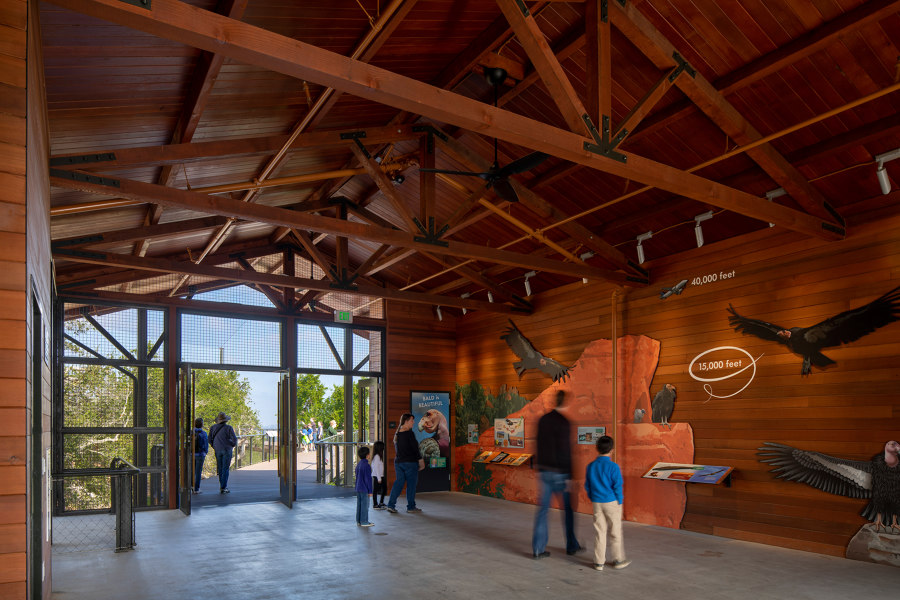The California Trail project at the Oakland Zoo doubles the size of the zoo complex to roughly 100 acres and furthers the zoo’s mission of conservation, education and research with a focus on native Californian animals. More than 20 years in the making, the $72 million project was a culmination of community collaboration and the dogged perseverance of the Conservation Society of Califor-nia. The project encompasses 26 structures spread across 50 acres of land, trails, as well as an aerial gondola system.
“We worked closely with the Zoo,” notes Janet Tam, Principal in charge of the project for Noll & Tam, “to minimize impact to the natural landscape, from the placement of the gondola that elimi-nates auto traffic to the careful siting of the boardwalk that preserves oak trees. The design inter-twines animal habitats with human habitats; animals have their feeding grounds and night houses to retreat to, much like visitors enjoy the Landing Cafe for refreshment then stroll over to the Interpre-tive Center for quiet reflection.”
The design is centered around conservation and experience. The siting of the project was a key element of both. Located in Knowland Park, the design is strategically located to preserve the natu-ral environment and the existing oak trees: it is placed where it would have the lightest impact on the land. To further lessen that impact, instead of developing roads and parking lots to transport visitors to the California Trail, visitors, fly over the landscape in a gondola. “The California Trail is designed to take visitors on a journey that awakens a call to action—a feeling of responsibility and personal commitment to protect the natural environment,” notes Tam.
The gondola ride begins the immersive experience of the California Trail, that also affords views of the San Francisco Bay area. Disembarking, visitors journey through a series of habitats—both expe-riential and educational. An 800-foot-long elevated boardwalk leads visitors through a series of exhibitions. The loop trail, which lightly touches the land, ends back at the 20,150-square-foot Visi-tor and Interpretive Center complex, which includes the gondola station and platform, offices, res-taurant, and restrooms. The Interpretative Center provides visitors with an opportunity to learn more about the history of the animals and the state of California. The design builds upon the institution’s mission, which aims to take visitors on a journey that awakens a call to action—a feeling of respon-sibility and desire for personal commitment to protect the natural environment.
The experience of the animals was as important as the experience of the visitors. The design team worked with the Zoo to understand the best practices of developing a stimulating, yet safe, envi-ronment for the animals. Eight native endangered and threatened California species (gray wolf, grizzly bear, black bear, mountain lion, bison, jaguar, California condor, and bald eagle) live amid rolling hills and oaks. The California Trail includes The Landing Café, an overnight campground, a treetop boardwalk, Bay vistas spanning seven counties, and a playground laid out to reflect the eco-logical zones of California. Inside the California Conservation Habitarium, children use hands-on learning to explore settings replicating mountains, deserts, redwoods, estuaries, and even an urban home. A large plaza connects the two buildings. Nearby, is the overnight campground, a place out-fitted with tent platforms and comfort facilities where children can learn about conservation and animals while spending the night outside. The campground also features learning kiosks that pro-vide resting spots with strategically oriented views toward animal exhibits and views of the San Francisco Bay region. The buildings themselves are simple, durable structures, designed to take second seat to the natural surroundings and the visitor experience. Sustainable design features are incorporated throughout, notably through collection and use of solar power and rainwater harvest-ing. “The commitment to fine tune the design while creating an immersive and interactive experience was an unprecedented collaboration with the whole team,” notes Tam. “Working together through-out the project, we were able to deliver something truly special.”
Noll & Tam’s work with the Oakland Zoo and its staff spans more than 20 years of successful col-laborations, and includes an administration building (1995), a front entry complex (2001), the Chil-dren’s Zoo (2005), and a veterinary hospital (2012).
Design team:
Noll & Tam Architects:
Janet Tam, Principal in Charge
Alyson Yarus, Project Manager
Michael Owens, Designer
Jason Barish, Designer
Ned Reifenstein, Designer
Project team:
East Bay Zoological Society (client)
Noll & Tam Architects (architecture and interior design)
Aliquot Associates, Inc. (civil engineering)
Ken Hughes (structural engineering)
Taylor Engineering (mechanical/plumbing engineering)
O’Mahony & Myer, Inc. (electrical engineering)
PJA Architects (landscape architecture)
PJA Architects (caging designer)
RAS Design Group (kitchen design)
Doppelmayr (gondola designer)
Overaa Construction (contractor)















































